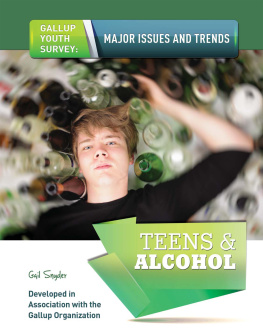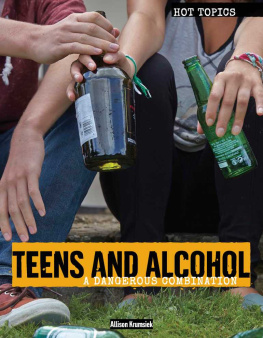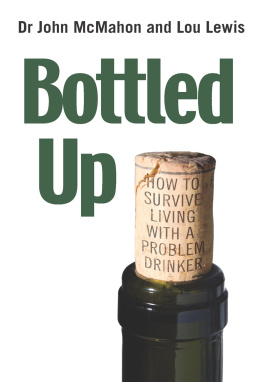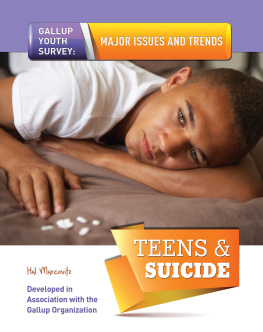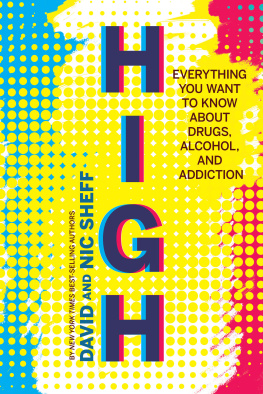

Teens & Alcohol
Teens & Career Choices
Teens & Cheating
Teens & Family Issues
Teens, Health, & Obesity
Teens & LGBT Issues
Teens & the Media
Teens & Race
Teens & Relationships
Teens, Religion, & Values
Teens & Sex
Teens & Suicide
Teens & the Supernatural/Paranormal
Teens & Volunteerism

 | Mason Crest
450 Parkway Drive, Suite D
Broomall, PA 19008
www.masoncrest.com |
2014 by Mason Crest, an imprint of National Highlights, Inc.
All rights reserved. No part of this publication may be reproduced or transmitted in any form or by any means, electronic or mechanical, including photocopying, recording, taping, or any information storage and retrieval system, without permission from the publisher.
Printed and bound in the United States of America.
CPSIA Compliance Information: Batch #GYS2013. For further information, contact Mason Crest at 1-866-MCP-Book
First printing
1 3 5 7 9 8 6 4 2
Library of Congress Cataloging-in-Publication Data
Snyder, Gail.
Teens and alcohol / Gail Snyder.
pages cm. (The Gallup youth survey : major issues and trends)
Includes bibliographical references and index.
Audience: Grade 7 to 8.
ISBN 978-1-4222-2949-1 (hc)
ISBN 978-1-4222-2994-1 (pb)
ISBN 978-1-4222-8866-5 (ebook)
1. TeenagersAlcohol useUnited StatesJuvenile literature. 2. AlcoholismUnited StatesJuvenile literature. 3. Drinking of alcoholic beveragesUnited StatesJuvenile literature. I. Title.
HV5135.S64 2014
362.29208350973 dc23
2013007186
The Gallup Youth Survey: Major Issues and Trends series ISBN: 978-1-4222-2948-4
Contents
By
A s the United States moves into the new century, there is a vital need for insight into what it means to be a young person in America. Todays teenagers will be the leaders and shapers of the 21st century. The future direction of the United States is being determined now in their hearts and minds and actions. Yet how much do we as a society know about this important segment of the U.S. populace who have the potential to lift our nation to new levels of achievement and social health?
We need to hear the voices of young people, and to help them better articulate their fears and their hopes. Our youth have much to share with their eldersis the older generation really listening? Is it carefully monitoring the hopes and fears of teenagers today? Failure to do so could result in severe social consequences.
The Gallup Youth Survey was conducted between 1977 and 2006 to help society meet this responsibility to youth, as well as to inform and guide our leaders by probing the social and economic attitudes and behaviors of young people. With theories abounding about the views, lifestyles, and values of adolescents, the Gallup Youth Survey, through regular scientific measurements of teens themselves, served as a sort of reality check.
Surveys reveal that the image of teens in the United States today is a negative one. Teens are frequently maligned, misunderstood, or simply ignored by their elders. Yet over four decades the Gallup Youth Survey provided ample evidence of the very special qualities of the nations youngsters. In fact, if our society is less racist, less sexist, less polluted, and more peace loving, we can in considerable measure thank our young people, who have been on the leading edge on these issues. And the younger generation is not geared to greed: survey after survey has shown that teens have a keen interest in helping those people, especially in their own communities, who are less fortunate than themselves
Young people have told Gallup that they are enthusiastic about helping others, and are willing to work for world peace and a healthy world. They feel positive about their schools and even more positive about their teachers. A large majority of American teenagers have reported that they are happy and excited about the future, feel very close to their families, are likely to marry, want to have children, are satisfied with their personal lives, and desire to reach the top of their chosen careers.
But young adults face many threats, so parents, guardians, and concerned adults must commit themselves to do everything possible to help tomorrows parents, citizens, and leaders avoid or overcome risky behaviors so that they can move into the future with greater hope and understanding.
The Gallup Organization is enthusiastic about this partnership with Mason Crest Publishers. Through carefully and clearly written books on a variety of vital topics dealing with teens, Gallup Youth Survey statistics are presented in a way that gives new depth and meaning to the data. The focus of these books is a practical oneto provide readers with the statistics and solid information that they need to understand and to deal with each important topic.
Alcohol use has been clearly identified as a major factor in many teen-related issues: highway deaths, accidental deaths and injuries, risky sex practices, poor school performance, depression, and suicide. The statistics are frightening. Yet many young people today are drinking illegally and irresponsibly.
Teens across the nation are at risk for alcohol-related problems. Underage drinking may lead to addiction and other physiological or psychological problems later in life. Young people who head to college without hard facts about alcohol abuse at their disposal may find themselves unprepared and vulnerable in the drink to get drunk environment of many campuses.
Parents and those who work with teens must be armed with the facts. This book examines alcohol and alcohol abuse among teens and in society in a comprehensive and non-judgmental way. It covers many vital topics, including myths about alcohol, signs that point to dependence, parental responsibility, and organizations that can help teens (and their families) get back on track.
Chapter One

In June 2001, twin sisters Barbara (left) and Jenna Bush (right) were cited for attempting to use false ID to obtain alcohol. The presidents daughters were among a rising number of American teenagers drawn to drinking.
I n June 2001, at a Tex-Mex restaurant called Chuys in Austin, Texas, two pretty, vivacious twin sisters walked in and ordered beers. The restaurant manager thought the 19-year-old girls looked underage so he asked them for identification. One of the girls quickly produced a drivers license. Aware that he could lose his liquor license and face a lawsuit for serving minors, he took his time looking over her I.D. Then he decided to make a phone call.
Instead of getting the beers they ordered, Jenna and Barbara got an unexpected visit from the police. Barbara, a student at Yale University, had never been arrested for underage drinking before, but her sister, then a freshman at the University of Texas in Austin, had gotten into trouble two months earlier for drinking at an Austin nightclub known as Cheers Shot Bar.
Next page
